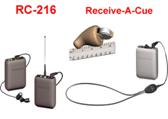Audio Playback Techniques:
 The musicians need to hear the music being played back. Usually, this is done by outputting the playback device to a conventional amplifier & loudspeaker system.
The musicians need to hear the music being played back. Usually, this is done by outputting the playback device to a conventional amplifier & loudspeaker system.
Professional musicians are often partially deaf from all their exposure to amplified music, and may demand that you use concert loud volume for playbacks. If so, make sure that you wear hearing protection (insertable earplugs) so that you and the rest of the crew don’t end up like them!
Most of the time, though, you ought to be able to get by with just audible playback levels from a small speaker/amp system.
Sometimes it will be necessary to record live dialog while a sync playback is going on in the background (more often done in feature films than music videos, but some artists do want to slip in a line of dialog or two). If this is the case, then you must be able to provide silent playback.
Silent playback may be as simple as just having the musicians wear small earpieces. Wires go down their necks, under their wardrobe, and eventually plug in to a headphone distribution box.
If the musicians (or dancers) are scantily clad, then we can use induction earpieces. These are similar to wireless hearing aids; they pick up audio transmitted by a local antenna. In the example of hearing aids, these wire loop antennas are worn around the collar region underneath clothing. They broadcast a weak signal up to the earpiece; hence there are no visible wires. For music videos, we run an antenna wire completely around the set and power it from a 200 to 400 watt audio amplifier (usually used to drive loudspeakers). The antenna wire is simply regular hobby wire connected to the speaker terminals of the amp. A resistor or two is added to the wire so that the amp does not burn itself out looking for the loudspeaker. Anyone located within the perimeter of the wire antenna will be able to hear the music (or instructions) in their miniature, hidden-in-the-ear earpieces.
Another silent playback technique is to replace the loudspeakers with sub-woofers. These sub-woofers are adjusted so that they can only put out extremely low frequency sounds, usually under 60 hertz. The musicians and dancers can feel the beat, but the pulses of the music are too low in frequency for motion picture microphones to hear.
